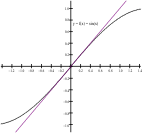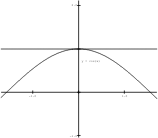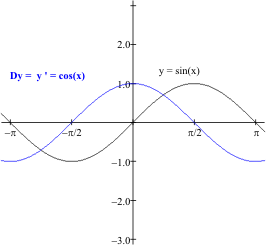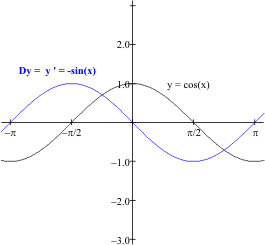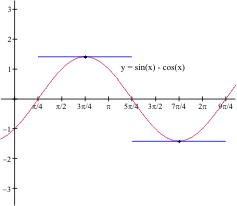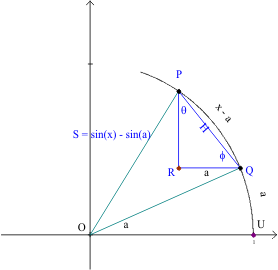Proof 1 of i)
$D_x\sin(x) = \sin'(x) =\cos(x)$ using $x \to a$: $f'(a) = \lim_{x \to a}\frac {f(x)-f(a)} {x-a}$.
Remark: Using Lemma I.F.8 it is not too hard to
find the general derivatives of the sine and cosine.
We will give the argument for the derivative of
the sine, leaving the proof for the cosine using the lemma as an exercise for the
reader.
In finding the derivative we'll use the
four step method based on the definition
with $f (x) = \sin(x)$.
Moving directly to Step II (subtract), Lemma I.F.8 i)
gives
$f (x)-f (a)
=\sin(x) - \sin(a)=2 \sin(\frac 12 (x - a)) \cos(\frac12 (x + a))$
Thus the difference quotient in Step III (divide) is
$\frac {f(x)-f(a)}{x-a} = \frac { \sin(x) - \sin(a)} {x-a}$
$= \frac {2 \sin(\frac 12 (x - a)) \cos(\frac12 (x + a))} {x-a}$.
$= \frac { \sin(\frac 12 (x - a))} {\frac 12 (x-a)} \cos(\frac12 (x +
a)) $.
For the purpose of the Step IV analysis (Think),
we first consider the factor $\frac { \sin(\frac 12 (x - a))} {\frac 12 (x-a)}$. Notice that
when $x$ is close to $a$, the expression $\frac 12 (x- a)$ is close
to $0$. Think of $\frac 12 (x- a)$ as a number which we can
call $h$. Now the factor is $\frac { \sin(h)} h$.
It's time to think! When $x \to a$ , $h \to 0$. Our work
in finding $\sin'(0)$ showed that $\frac { \sin(h)} h \to 1 $, or
equivalently, $\frac { \sin(\frac 12 (x - a))} {\frac 12 (x-a)} \to 1$.
Using the definition of the cosine
function on the
unit circle should make it sensible to see that when $x \to a$ , $\frac
12 (x+ a) \to a$, and thus $\cos( \frac 12 (x + a)) \to \cos(a)$.
Putting this all together, we have
$f'(a) = \lim_{x \to a}\frac {f(x)-f(a)} {x-a}$
$=\lim_{x \to a}
\frac { \sin(x) - \sin(a)} {x-a}$
$= \lim_{x \to a}\frac { \sin(\frac 12 (x - a))} {\frac 12
(x-a)} \cos(\frac12 (x + a)) $
$= \cos(a)$
So replacing $a$ with $x$ we have the general
result: $D_x\sin(x) = \sin'(x) =\cos(x)$. EOP.
|
Proof 2 of i)
$D_x\sin(x) = \sin'(x) =\cos(x)$ using $h \to 0$:
$f'(a) = \lim_{h \to 0}\frac {f(a+h)-f(a)} {h}$.
Remark: In this proof we make use of the
addition identity:
$\sin(A+B) = \sin(A)\cos(B) + \cos(A)\sin(B)$
In finding the derivative this time we'll use the
four step method based on the definition
with $f (x) = \sin(x)$.
Moving directly to Step II (subtract),the addition
identity for the sine gives
$f(a+h)-f(a) = \sin(a+h) - \sin(a)$
$= \sin(a)\cos(h) + \cos(a)\sin(h) - \sin(a)$
$= \cos(a)\sin(h) + \sin(a) [\cos(h) -1]$.
Thus the difference quotient in Step III (divide) is
$\frac {f(a+h)-f(a)}h = \frac { \sin(a+h) - \sin(a)} h$
$= \frac { \cos(a)\sin(h) + \sin(a) [\cos(h) -1]} h$.
$= \cos(a)\frac { \sin(h) }h + \sin(a) \frac {[\cos(h) -1]} h$.
For the purpose of the Step IV analysis (Think),
we first consider the term $ \cos(a)\frac { \sin(h) }h$.
Notice that
when $h$ is close to $0$, our work in finding $\sin'(0)$
showed that $\frac { \sin(h) }h \to 1$, so it should make sense
that $ \cos(a)\frac { \sin(h) }h \to \cos(a)$.
Now consider the term $\sin(a) \frac {[\cos(h) -1]} h$ . Our recent work in finding $\cos'(0)$ showed that
$\frac {\cos(h)-1} h \to 0$, so it should make sense that
$\sin(a) \frac {[\cos(h) -1]} h \to 0$ .
Putting this all together, we have
$f'(a) = \lim_{h \to 0}\frac {f(a+h)-f(a)} {h}$
$= \lim_{h \to 0} \frac { \sin(a+h) - \sin(a)}
h$
$= \lim_{h \to 0} \cos(a)\frac {
\sin(h) }h + \sin(a) \frac {[\cos(h) -1]} h$
$= \cos(a) + 0$.
So replacing a with x we have the general
result: $D_x\sin(x) = \sin'(x) =\cos(x)$. EOP.
|
